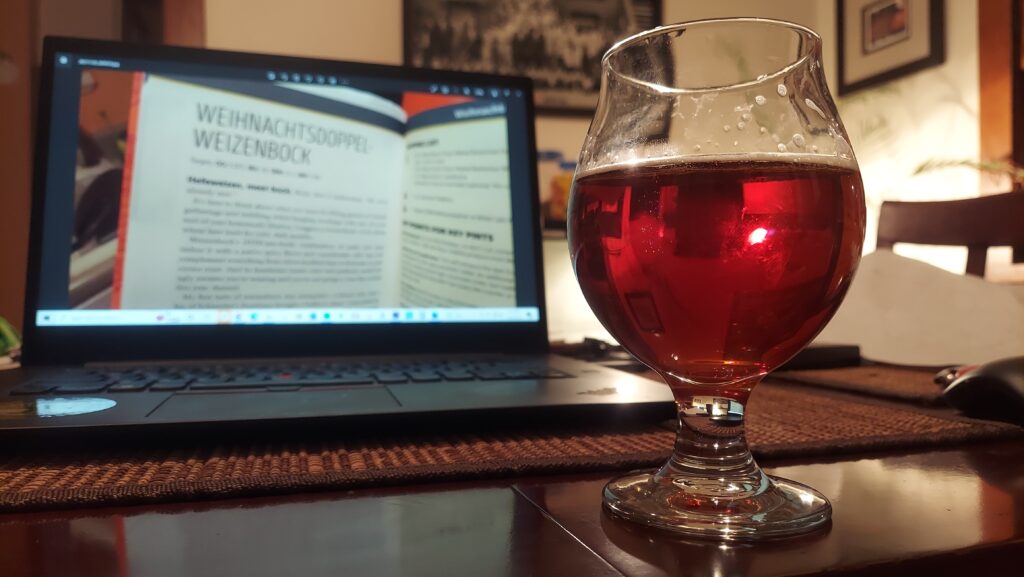
Recipe reprinted with permission from Mashmaker by Michael Dawson. Learn more about the Chop & Brew brew day and tasting notes in this 12 Beers of Christmas 2022 video.
Targets:
OG: 1.072, IBU: 30, SRM: 11.1, ABV: 7.4%
Hefeweizen, meet bock. Bock, this is hefeweizen. “Oh, we’ve already met.”
It’s time to think about what you want for filling glasses at Yuletide gatherings and imbibing while hanging stockings with care. For your end-of-year homemade libation, I suggest a weizenbock: a rich, strong wheat beer built for cold, dark months.
Weizenbock’s (VITE-zen-bock) combination of malts and yeast imbue it with a native spicy flavor and considerable ABV that will complement everything from clove-studded ham to fruitcake to pork crown roast. And its handsome russet color will perfectly match the ugly sweater you’re wearing and you’re not going to lose the contest this year, dammit.
My first taste of weizenbock was exemplary—a friend who was a fan of Schneider’s Aventinus brought a bottle to share. I was jolted by the depth and complexity, and, being familiar only with more modest, standard-gravity hefeweizens and dunkelweizens, unprepared for the strength. Weizenbock is not a guzzler, citizens. The OG straddles the bock-doppelbock divide (1.064−1.090) with a fairly high FG (1.015−1.022) for at best an off-dry finish. Fat-bottom beers, you make the rockin’ world go round.
Like any good doppelbock, weizenbock takes on color, intensity, and bready goodness from Munich and/or Vienna malts—high-kilned base malts commonly used in dark German beers. And like an authentic Suddeutsche hefe, weizenbock relies on a high percentage of malted wheat for a velvety texture and rising-yeast-dough flavor. Fermentation with a traditional hefeweizen yeast strain leaves the finished beer with aromatic high notes.
In the spirit of brewing beer at home for you and your family this holiday season, here’s a version with a really long German name. This recipe isn’t an Aventinus clone, but, like most other weizenbocks, it does owe an inspirational debt to the original.
SHOPPING LIST
- 6 lbs. Weyermann Floor-Malted Bohemian Dark (an heirloom version of Munich malt—check it out!)
- 6 lbs. Weyermann Floor-Malted Bohemian Wheat
- 6 oz. Weyermann CaraAroma
- A handful of oat or rice hulls (optional: this can help prevent a stuck sparge)
- 2 oz. German Tradition
- Imperial Yeast G01 Stefon, Wyeast 3068 Weihenstephan or White Labs WLP300 Hefeweizen
KEY POINTS FOR KEY PINTS
Malt showcase: It’s for the holidays, so don’t cut corners on the grain bill. Quality in, quality out, citizens. I like the floor-malted products from Weyermann for a beer like this.
A little bit of CaraAroma: This will enhance the dark fruit character and create a nice bass counterpoint to the spicy aromatic treble. An additional tiny amount of roast grain wouldn’t go amiss, lending some light chocolate notes, but tradition demands we don’t overdo the Carafa. Weizenbock shouldn’t be roasty like a porter or stout. Although, this is your beer, so maybe go nuts.
No cloying: Even if a beer is big and malty, it shouldn’t drink like a diabetic coma-inducing milkshake. This recipe calls for a fairly low mash rest to lean out the body, plus bitterness at the high end of the scale to balance the inherent sweetness of the beer.
Keep fermentation under 70°F: This will prevent the yeast character from becoming overpowering, and prevent the warming alcohol component of this strong beer from becoming harsh and solvent-like.
BREWING
PREP
- Make a yeast starter. Mill the grains, then heat strike water to approximately 165°F.
MASH & SPARGE
- Mash rest: Add grain to strike water and mix to 152°F, and rest for 60−90 minutes.
- Option: If you have the time, mash tun space, and inclination, a more intensive weissbier mash schedule can be used: 115°F for 15 min., 129°F for 15 min., 148°F for 30 min., 156°F for 15 min.)
- While the mash rests, collect and heat sparge water.
- Mashout: Heat it to 170°F for 5 minutes.
- Sparge and collect the wort in the boil kettle.
BOIL (60 minutes)
- T-60: 2 oz. German Tradition.
- T-0: Cool it, transfer to a sanitized fermentor, aerate well, and pitch yeast.
FERMENTATION AND BEYOND
- Primary fermentation: 64-68°F for approximately 7−10 days.
- Secondary fermentation: Another 7−14 days conditioning.
- The beer should be ready to package after 3−4 weeks, and will start to hit its stride 6−8 weeks from brewing day. Stored cold and dark, it will drink well for months.
